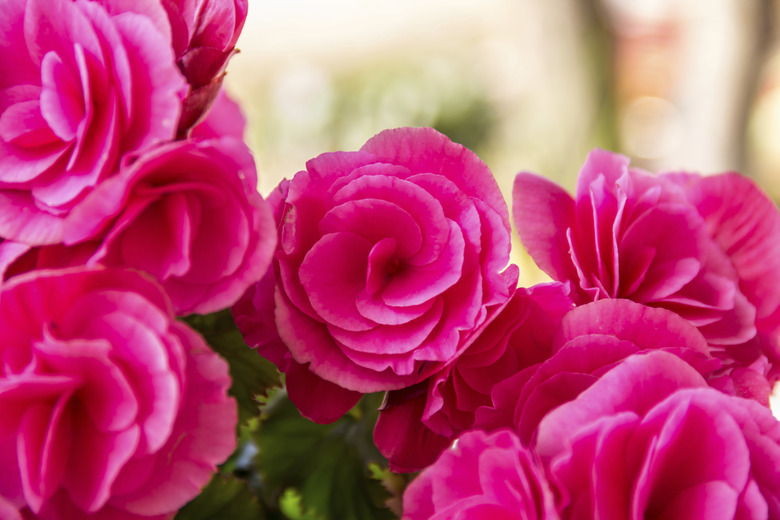Why Are My Begonias Dying?
Botanists have classified begonias (Begonia spp.) into three major groups based on their root structure: fibrous, rhizomatous and tuberous. The begonia, with over 1,000 different species, originated in the tropics. Some begonias offer not only delicate, colorful blossoms but also decorative foliage. Begonias thrive year-round in U.S. Department of Agriculture plant hardiness zones 7 to 10. Although begonias can be fun to grow, they are susceptible to a number of pests and diseases.
Bacteria and Blight
Bacterial leaf spot is one of the most common diseases affecting all varieties of begonias. Leaves develop small spots with yellow halos. The spots begin dark in color and lighten over time. Leaves die and drop. In advanced stages, the disease causes systemic infection and plant wilting. Botrytis leaf blight is a fungus causing tan spots that rapidly enlarge and cover the leaf. Dusty gray or green fungus may also appear. This fungus thrives in cool temperatures and high humidity. Rhizoctonia blight starts at the base of plant stems next to the soil. Look for reddish-brown fungus like a spider web. Southern blight affects the whole begonia plant but is most visible on leaves. This blight causes the growth of coarse white fungus in a fan-like pattern. Destroy all symptomatic plants affected by bacteria or blight.
Mildew and Rot
Powdery mildew can affect leaves, blossoms, or stems. The mildew looks like white powder and causes the underlying tissue to die. Pythium rot is the likely culprit if plants wilt and break at the soil line. This disease typically comes from contaminated soil. Look for black decaying spots on stems. Rhizoctonia crown rot is similar to Pythium rot, as it causes stems to decay at the soil line. A fungal web grows between the stems and soil. Destroy all symptomatic plants affected by mildew or rot.
Insects and Pests
In addition to bacterial and fungal attacks on begonias, a plethora of insects and pests can also cause problems. If you notice a spot of sooty black mold in conjunction with stunted growth, aphids and mealy bugs may be to blame. Mites cause new leaves to cup downward and pucker. Snails, slugs and thrips feed on leaves, resulting in irregular holes, scarred and calloused foliage. Whiteflies turn leaves yellow and also leave behind black sooty mold spots. The larvae of fungus gnats produce webs on the soil; they also damage roots and leaves touching the soil. Caterpillars leave their feeding holes and excrement behind. Foliar nematodes cause red pigmentation and brown spots on leaves, while other nematodes cause knots to grow on roots. Aster Yellows is a disease caused by leafhoppers that results in spindly growth and yellow veins on young begonia leaves.
Remove any damaged leaves or stems and treat plants affected by insect pests with a horticultural oil and baking soda mix. Mix 1 tablespoon horticultural oil and 1 tablespoon baking soda with 1 gallon of water. Spray each plant, covering both the topside and underside of leaves. Spray twice the first week, then assess whether the plant is improving. In the case of severe infestation, destroy the plant.
Defense Protocol
Pests and diseases that attack begonias may be avoided by following a defense protocol.
-
Thoroughly spray plants weekly with the horticultural oil and baking soda mix. This mixture serves as a non-toxic deterrent to fungal, bacterial and pest-related problems with begonias.
-
Avoid overhead watering that wets leaves, and ensure water does not splash from plant to plant.
-
Wash your hands frequently when handling plants.
-
Sterilize gardening tools by soaking in 70 percent rubbing alcohol for one minute. Do not rinse. Air dry.
-
Use only use disease-free plants for cutting and propagation.
-
Use only pasteurized soil and planting mediums.
References
- Penn State Extension: Begonia Diseases
- Texas A&M AgriLife Extension: Texas Plant Disease Handbook: Begonia
- Michigan University State Extension: Bacterial Leaf Spot of Begonia
- University of Florida: Begonia Production Guide
- Texas A&M AgriLife Extension: Begoniaceae Begonia Family
- Pacific Horticulture: A Bounty of (Hardier) Begonias
